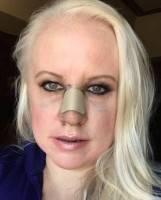Hispanic Ethnic Rhinoplasty
Successful rhinoplasty in Hispanic patients
Not all Hispanic patients have the same nasal anatomy, therefore you can not apply the same techniques to all Hispanic patients.
There are some unique characteristics in Hispanic rhinoplasty patients, such as thicker nasal skin, weaker nasal tip cartilages, somewhat underdeveloped bridge, etc.
As you probably have learned by now rhinoplasty is one of the more difficult procedures for a surgeon to master. Some surgeons are able to perform rhinoplasty in one specific fashion.
It is imperative that an experienced and talented surgeon thoroughly assess the patient’s facial anatomy and proportions, only then an appropriate surgical approach can be planned.
In my practice we offer computer imaging to our prospective rhinoplasty patients, so that the goals and aspirations of the patients can be communicated.
Of course not all surgeons that can created changes on the computer can produce those changes in the operating room. Pick you rhinoplasty surgeon carefully. You might find it insightful to read my article “The Art of Sculpting the Nose” which can be found on my web site under “publications” (Boris M. Ackerman, MD, Newport Beach Plastic Surgeon)
Rhinoplasty in Hispanic patients
Rhinoplasty is a popular and effective surgery to recontour the shape of your nose. As every patient is unique, so should every rhinoplasty. Here in Miami, we commonly perform rhinoplasty on Hispanic patients.
Although described as Hispanics, there is a huge variety in our cultures and genetic backgrounds (I myself am from Ecuador). For this reason, your best bet is to work with a board-certified plastic surgeon who has a great deal of experience in rhinoplasty and ethnic rhinoplasty. They will be able to examine you and your nose and explain how the different components of your nose will each be addressed during your surgery.
Hispanic patients with thin skin but a prominent bony framework will be treated very differently then a Hispanic patient with a low nasal bridge but very thick skin. In our practice, we find the use of digital photography and digital morphing software to be essential. We morph the photograph of every patient as this is an excellent education and communication tool that allows us to fully understand what the goals of the patient are and to show them what is realistically possible. Be sure that he find a surgeon that can offer this important tool to you as well. (Pat Pazmino, MD, Miami Plastic Surgeon)
Your Ancestry and How it Affects Your Rhinoplasty
The first thing to realize about any individual is just that, they are a single unique individual. That person needs to be evaluated and treated without preconceived notions. Having said that, clearly there are similarities among people of different genetic backgrounds. Being aware of those traits and having experience with them is invaluable. With Hispanic individuals you more often see thicker skin, softer cartilage, a broader base, and less prominent profile.
The most difficult challenge is the thicker skin. With thick skin it is a challenge to alter the shape of the nose because much of the work done to the skeleton underneath simply gets covered up. Attempting to thin the skin is a bad idea as complications can be devastating. Before surgery, you and your surgeon need to estimate just what kind of change is possible and work in that mindset. If you have expectations that are reasonable, you will likely be pleased. (Louis W. Apostolakis, MD, Austin Facial Plastic Surgeon)
Ethnic differences with Rhinoplasty for Hispanic patients
The term Hispanic refers to a wide variety of ethnic groups, which can range from Spanish to Mayan to Portuguese characteristics. However, the “classic” Hispanic nose is one that has some features of African-Americans with weak cartilages, wide nasal bridge, thick skin, and underprojected tip. As such, a surgeon experienced in dealing with these different features can improve upon them, creating the desired cosmetic improvement after discussion- and in my hands, computer imaging- of the patient’s goals. (Jeffrey Epstein, MD, FACS, Miami Facial Plastic Surgeon)
Hispanic rhinoplasty
There are some characteristics of Hispanic ethnicity which allow for some differences in approach in both males and females when performing a rhinoplasty. Specifically the nasal bones are a bit thicker and the skin slightly thicker as well.
These, of course, are generalities and individual variations will vary considerably. (Talmage J. Raine, MD, FACS, Champaign Plastic Surgeon)
Individuals of Hispanic background exhibit skin that is oily, thick, and olive in color. These traits slow the healing process when compared to non-Hispanic patients.
As a result, it takes longer for the final results of the surgery to emerge. Hispanic Rhinoplasty sometimes requires structural cartilage grafting, which prolongs swelling in the area above the tip of the nose.
These patients require sometimes require cortisone shots in the tip of the nose during the post-operative healing phase to bring down the swelling. (William Portuese, MD, Seattle Facial Plastic Surgeon)
Rhinoplasty in ethnic patients
There may or may not be any specific differences in a given Hispanic patient. In general, Latino patients have thicker skin and poor tip support but that is not an absolute and by no means a 100% rule.
Your surgeon should be able to evaluate your nose and determine what techniques should be used to deal with your anatomy to give you the best results. (Jason B. Diamond, MD, Beverly Hills Facial Plastic Surgeon)
Rhinoplasty in Hispanic Patients
Being in a border town like San Diego, we have quite a bit of experience in Hispanic rhinoplasty patients.
Some of the major differences between Hispanic rhinoplasty patients and other ethnic rhinoplasty patients include a thicker, oily soft tissue skin covering.
In addition, Hispanic noses tend to have a more rounded, wider appearance overall. What this means for the rhinoplasty surgeon is that more work needs to be done to the underlying cartilage and bone structural framework in order for the changes to become more visible.
This usually necessitates more cartilage grafting to allow more definition to be appreciated through the thicker skin. It also means that healing can be more prolonged in Hispanic patients, sometimes by as much as a few months longer.
As in other ethnic rhinoplasty patients, the changes made to the nose also need to respect the surrounding facial features to maintain ethnic consistency and balance. (John M. Hilinski, MD, San Diego Facial Plastic Surgeon)
Rhinoplasty is different for every individual I treat. In general, My hispanic patients tend to have thicker tissues, and sometimes flatter and wider noses than some of my caucasian patients.
Sometimes I have to add a graft onto the bridge of their nose to give them a better projection of the dorsum or profile. Work on the tip itself can be difficult to appreciate if the tissues are thick. They may prevent the fine detail of work that is done on the tip that would be more evident in a thinner skinned person. (Steven Wallach, MD, Manhattan Plastic Surgeon)


